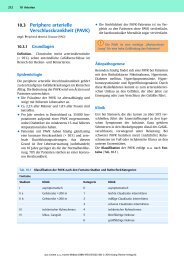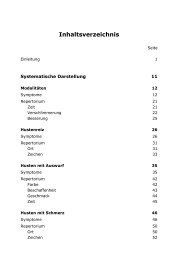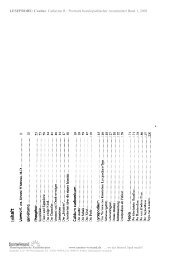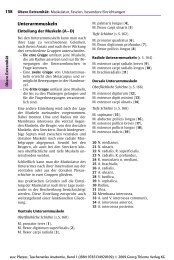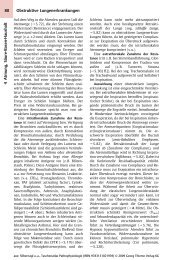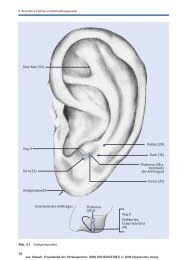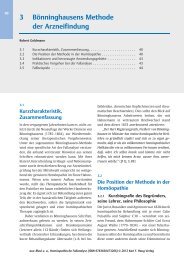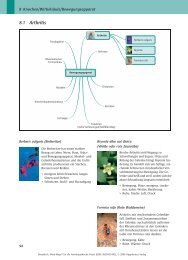alphabetical index of plant families and groups - Sunrise Versand
alphabetical index of plant families and groups - Sunrise Versand
alphabetical index of plant families and groups - Sunrise Versand
Create successful ePaper yourself
Turn your PDF publications into a flip-book with our unique Google optimized e-Paper software.
controls reactions to stress. The HPA axis response to stress is generally higher in<br />
women than in men.<br />
The key hormones <strong>of</strong> the HPA axis include vasopressin, known as antidiuretic<br />
or water conservation hormone, <strong>and</strong> corticotropin-releasing hormone, CRH.<br />
Vasopressin <strong>and</strong> CRH stimulate the secretion <strong>of</strong> adrenocorticotropic hormone,<br />
ACTH, which in turn acts on the adrenal cortices, which produce glucocorticoid<br />
hormones, mainly cortisol in humans, in response to stimulation by ACTH.<br />
Cortisol is a major stress hormone <strong>and</strong> has effects on many tissues in the body,<br />
including the brain. In healthy individuals, cortisol rises rapidly before or right<br />
after wakening, reaching a peak within 30–45 minutes. About 80% <strong>of</strong> the day’s<br />
cortisol is secreted in this early morning time, getting a person pepped up for the<br />
day. It then gradually falls over the day, rising again in late afternoon about<br />
4 p.m. Cortisol levels continue falling through the evening, reaching a trough<br />
during the middle <strong>of</strong> the night, only to sharply rise again when a new day starts.<br />
If adrenaline is the short-term, immediate danger, flight or fight hormone, then<br />
cortisol is the hormone <strong>of</strong> long-term continuous danger or stress. It picks up after<br />
adrenaline wears <strong>of</strong>f.<br />
Cortisol deficiency or an abnormally flattened circadian cortisol cycle has been<br />
linked with chronic fatigue syndrome, insomnia <strong>and</strong> burnout. Increased production<br />
<strong>of</strong> cortisol results from long-term alarm reactions to stress where adapting<br />
to the chronic on-going presence <strong>of</strong> stress is necessary for survival. The person is<br />
adapting to stress <strong>and</strong> the price for that adaptation is very high indeed. Many<br />
immune related conditions, including rheumatoid arthritis, arteriosclerosis <strong>and</strong><br />
even cancer can be the result <strong>of</strong> living with elevated cortisol levels chronically.<br />
A spectrum <strong>of</strong> conditions may be associated with increased <strong>and</strong> prolonged activation<br />
<strong>of</strong> the HPA axis, including melancholic depression, anorexia nervosa with<br />
or without malnutrition, obsessive compulsive disorder, panic anxiety, chronic<br />
active alcoholism, alcohol <strong>and</strong> narcotic withdrawal, excessive exercising, poorly<br />
controlled diabetes mellitus, childhood sexual abuse <strong>and</strong> hyperthyroidism.<br />
Hypoactivation or depletion <strong>of</strong> the stress system, on the other h<strong>and</strong>, has been<br />
linked with post-traumatic stress disorder, atypical seasonal depression, chronic<br />
fatigue syndrome, fibromyalgia, hypothyroidism, post stress conditions, postpartum,<br />
menopause <strong>and</strong> nicotine withdrawal.<br />
Neurasthenia<br />
Stress related syndromes are not at all new. In 1869 George Miller Beard first used<br />
the term neurasthenia to denote a condition with symptoms <strong>of</strong> fatigue, anxiety,<br />
headache, impotence, neuralgia <strong>and</strong> depressed mood. Americans were supposed<br />
to be particularly prone to neurasthenia, which resulted in the nickname the<br />
Great American Disease or ‘Americanitis’, popularised by William James. Just as<br />
today with chronic fatigue syndrome, in the late 1800s neurasthenia became a<br />
popular diagnosis, exp<strong>and</strong>ing to include such symptoms as weakness, dizziness<br />
<strong>and</strong> fainting. A common treatment was the rest cure, especially for women, who<br />
were the gender primarily diagnosed with the condition at that time. It was<br />
explained as being a result <strong>of</strong> exhaustion <strong>of</strong> the central nervous system’s energy<br />
reserves, which Beard attributed to civilisation. He might be credited with first<br />
© Saltire Books Ltd<br />
Family ARALIACEAE 487



